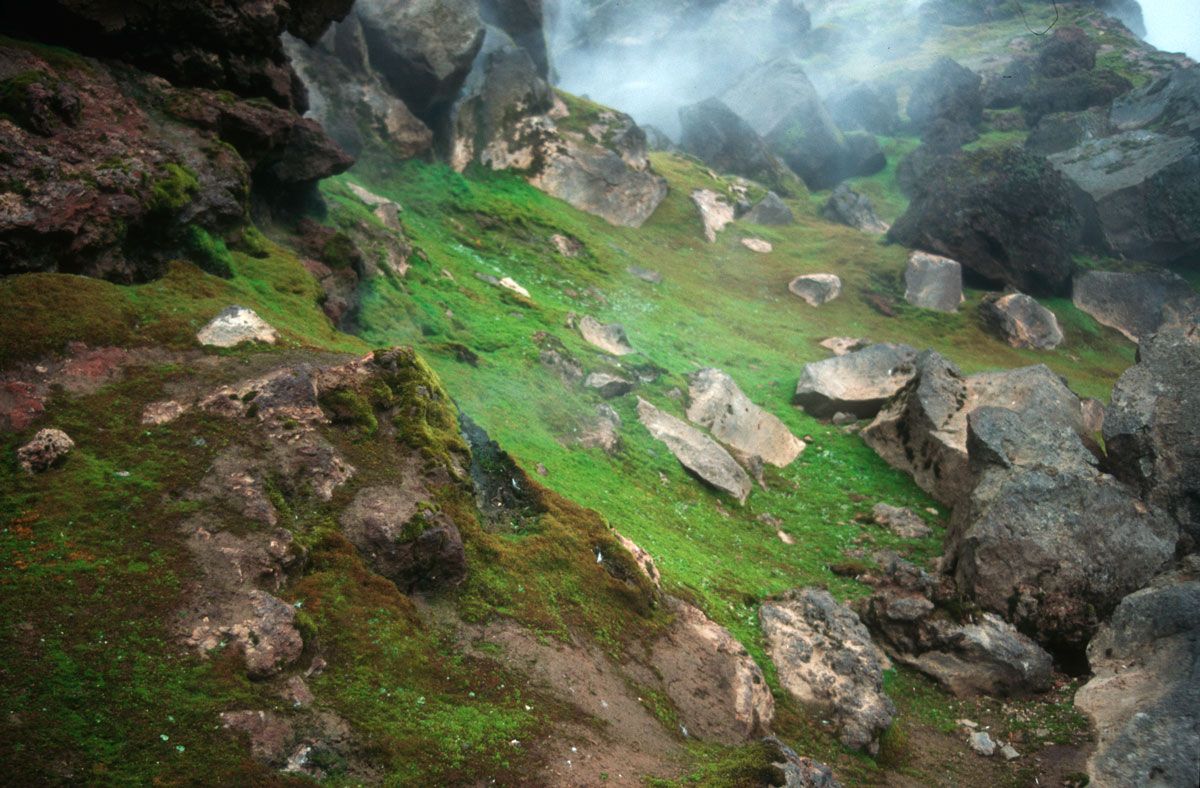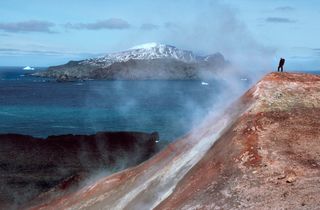
Volcanoes Helped Antarctic Life Weather Ice Ages

Like an ice age radiator, heat from volcanoes helped Antarctica's plants and bugs survive Earth's glacial periods, scientists think based on the result of a new study.
The findings suggest that volcanoes can provide a cozy home for plants and animals during ice ages, either in ice caves or on warm ground heated by geothermal features such as hot springs, the researchers said. The study was published today (March 10) in the journal Proceedings of the National Academy of Sciences.
"Volcanoes are generally seen as these big, explosive destroyers of life, but they might be important in promoting biodiversity," said Ceridwen Fraser, a biogeographer at Australian National University in Canberra and lead study author. "This explains how life survived in Antarctica, but we think this idea of geothermal refuges could also apply elsewhere."
Frozen in place
Today, mosses, lichens and small invertebrates thrive along Antarctica's coast. In some spots, the bright green mosses form a thick, lush carpet, growing up to 10 feet (3 meters) deep.
But even these hardy plants suffered during Earth's last ice age 20,000 years ago, when the planet's temperature dropped and Antarctica's ice sheets covered nearly all its land and cloaked the sea.
Genetic and fossil evidence suggests that during the ice age, any Antarctic species that could cross the Southern Ocean fled, with penguins, seals and birds heading for warmer refuges. "The only species that were left in Antarctica were those that couldn't get off," Fraser said.
Sign up for the Live Science daily newsletter now
Get the world’s most fascinating discoveries delivered straight to your inbox.
Genetic analyses also indicate that Antarctica's mosses, lichens and small invertebrates have been isolated from their relatives on other continents for millions of years. More than 60 percent of its bugs live nowhere else on Earth. This means these species probably survived the ice age by sheltering in place, rather than repopulating Antarctica by crossing the vast Southern Ocean after the ice age ended.
A hot haven
A BBC television documentary on Mount Erebus, Antarctica's largest volcano, inspired Fraser and her colleagues to test whether Antarctica's volcanoes were an ice age haven. Mount Erebus is an active volcano, with ice caves that harbor microbial life today. [Fire and Ice: Images of Volcano-Ice Encounters]
"I thought that ice caves would be a fantastic place for life to hang out during an ice age," Fraser told Live Science's Our Amazing Planet. "We decided to look at whether there was any evidence that these species could have survived at volcanoes, and that is what we found."
Antarctica has at least 16 volcanoes that have erupted in the past 20,000 years (more evidence of as yet undiscovered eruptions could be hidden below the ice.) At spots such as Deception Island, underlain by a large magma chamber, geothermal heating could have kept the ground ice-free during the past ice age, the researchers said.
"These were not only ice-free, but much warmer," Fraser said. "These were really nice, warm places."
Fraser and her co-authors analyzed more than 38,000 records of Antarctic species, and discovered there are more moss, lichen and bug species close to Antarctica's volcanoes, and fewer farther away.
The pattern supports the idea that these species weathered the worst of the ice age at Antarctica's volcanoes, then gradually expanded their habitat range after the ice receded.
"This suggests that all of the colonization has been from the volcanoes slowly over time," Fraser said.

Bringers of life
Another potential ice age refuge was Antarctica's nunataks, isolated peaks that are surrounded by ice. But nunataks usually have a unique assortment of life that is different from lowland species, so it's unlikely that plants and small invertebrates repopulated the coast from nunataks, Fraser said.
In the Northern Hemisphere, scientists have also discovered fossil evidence of ice age refuges in the high latitudes, where plants such as white spruce trees thrived in places like Norway, despite chilly weather and giant glaciers. These "cryptic refugia" have not yet been directly linked to volcanoes or geothermal areas.
"We know that they existed but we don't know why," Fraser said. "We think that volcanoes and geothermal areas could have potentially helped life survive in those regions as well."
Fraser and her colleagues now plan to test whether the genetic patterns of moss and other species also support the idea of volcanic refuges in Antarctica.
Email Becky Oskin or follow her @beckyoskin. Follow us @OAPlanet, Facebook and Google+. Original article at Live Science's Our Amazing Planet.











